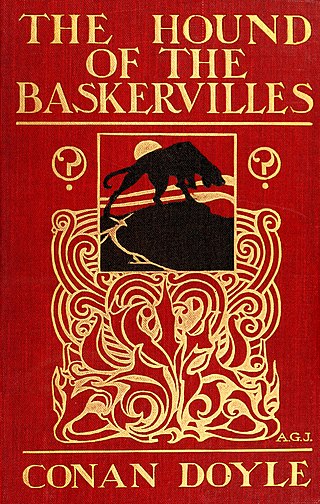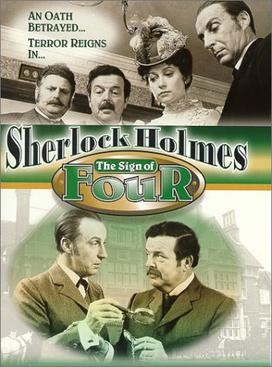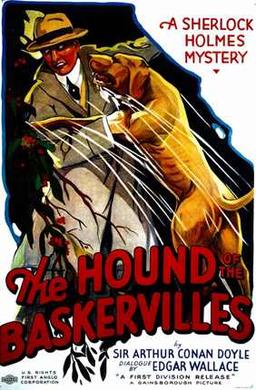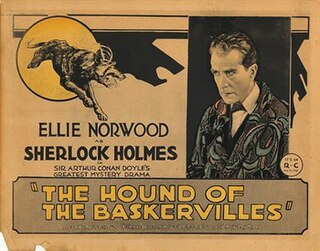
The Hound of the Baskervilles is the third of the four crime novels by British writer Arthur Conan Doyle featuring the detective Sherlock Holmes. Originally serialised in The Strand Magazine from August 1901 to April 1902, it is set largely in Dartmoor, Devon, in England's West Country and follows Holmes and Watson investigating the legend of a fearsome, diabolical hound of supernatural origin. This was the first appearance of Holmes since his apparent death in "The Final Problem", and the success of The Hound of the Baskervilles led to the character's eventual revival.

The Exploits of Sherlock Holmes is a short story collection of twelve Sherlock Holmes pastiches, first published in 1954. It was written by Adrian Conan Doyle, who was the son of Sir Arthur Conan Doyle, and by John Dickson Carr, who was the authorised biographer of the elder Conan Doyle. The first six stories were written in collaboration by the two writers, while the last six stories were written solely by Adrian Conan Doyle.

Detective Inspector G. Lestrade is a fictional character appearing in the Sherlock Holmes stories written by Arthur Conan Doyle. Lestrade's first appearance was in the first Sherlock Holmes story, the 1887 novel A Study in Scarlet. His last appearance is in the 1924 short story "The Adventure of the Three Garridebs", which is included in the collection The Case-Book of Sherlock Holmes.

The Hound of the Baskervilles is a 1981 Soviet television film adaptation of Arthur Conan Doyle's 1902 novel The Hound of the Baskervilles. It was the third instalment in the TV series about adventures of Sherlock Holmes and Doctor Watson.

The Hound of the Baskervilles is a 1959 British gothic mystery film directed by Terence Fisher and produced by Hammer Film Productions. It is based on the 1902 novel of the same title by Sir Arthur Conan Doyle. It stars Peter Cushing as Sherlock Holmes, Sir Christopher Lee as Sir Henry Baskerville and André Morell as Doctor Watson. It is the first film adaptation of the novel to be filmed in colour.

The Hound of the Baskervilles is a 1939 American gothic mystery film based on the 1902 Sherlock Holmes novel of the same name by Sir Arthur Conan Doyle. Directed by Sidney Lanfield, the film stars Basil Rathbone as Sherlock Holmes and Nigel Bruce as Dr. John Watson. Released by 20th Century Fox, it is the first of fourteen Sherlock Holmes films produced between 1939 and 1946 starring Rathbone and Bruce.
The Hound of the Baskervilles is a 2002 television adaptation of Sir Arthur Conan Doyle's 1902 novel of the same name.

The Hound of the Baskervilles is a 1978 British comedy film spoofing the 1902 novel The Hound of the Baskervilles by Sir Arthur Conan Doyle. It starred Peter Cook as Sherlock Holmes and Dudley Moore as Dr. Watson. A number of other well-known British comedy actors appeared in the film including Terry-Thomas, Kenneth Williams and Denholm Elliott.

The Hound of the Baskervilles is a 1937 German mystery film directed by Carl Lamac and starring Peter Voss, Fritz Odemar and Fritz Rasp. It is an adaptation of the 1902 Sherlock Holmes story The Hound of the Baskervilles by Arthur Conan Doyle. It was shot at the Babelsberg Studios in Potsdam and on location at the neo-Gothic Moyland Castle. The film's sets were designed by the art directors Wilhelm Depenau and Karl Vollbrecht.

The Sign of Four is a 1983 British made-for-television mystery film directed by Desmond Davis and starring Ian Richardson and David Healy. The film is based on Sir Arthur Conan Doyle's 1890 novel of the same name, the second novel to feature Sherlock Holmes and Doctor Watson.
The Hound of the Baskervilles is a Canadian television film directed by Rodney Gibbons and starring Matt Frewer and Kenneth Welsh. The film is based on Arthur Conan Doyle's 1902 Sherlock Holmes novel of the same name.
Sherlock Holmes is a film series running from 1931 to 1937. Arthur Wontner portrayed Sherlock Holmes in five films.

The Hound of the Baskervilles is a 1932 British mystery film directed by Gareth Gundrey and starring John Stuart, Robert Rendel and Frederick Lloyd. It is based on the 1902 novel The Hound of the Baskervilles by Arthur Conan Doyle, in which Sherlock Holmes is called in to investigate a suspicious death on Dartmoor. It was made by Gainsborough Pictures. The screenplay was written by Edgar Wallace.

The Hound of the Baskervilles is a 1921 British silent mystery film directed by Maurice Elvey and starring Eille Norwood, Catina Campbell and Rex McDougall. It is based on the 1902 Sherlock Holmes novel The Hound of the Baskervilles by Arthur Conan Doyle. It was made by Stoll Pictures, Britain's largest film company at the time. It was the first British film adaptation of the famous novel.

The Hound of the Baskervilles is a 1972 American made-for-television mystery film directed by Barry Crane and starring Stewart Granger as Sherlock Holmes and Bernard Fox as Doctor Watson. The movie is based on Arthur Conan Doyle's 1902 Sherlock Holmes novel The Hound of the Baskervilles.
The Hound of the Baskervilles is a 1982 British television serial made by the BBC. It was produced by Barry Letts, directed by Peter Duguid, and starred Tom Baker as Sherlock Holmes and Terence Rigby as Doctor Watson. The adaptation aired as a four-part serial. The serial is based on Arthur Conan Doyle's 1902 Sherlock Holmes novel The Hound of the Baskervilles. The music score was composed and conducted by Carl Davis.
Der Hund von Baskerville is a 1914 German silent film adaptation of Arthur Conan Doyle's 1902 novel The Hound of the Baskervilles, the first film adaptation of the work. According to the website silentera.com, the film was considered lost, but has been rediscovered; the Russian Gosfilmofond film archive possesses a print, while the Filmmuseum München has a 35mm positive print.
Hands of a Murderer is a 1990 British made-for-television mystery film directed by Stuart Orme, starring Edward Woodward as Sherlock Holmes and John Hillerman as Dr. John H. Watson.

The Hound of the Baskervilles is a 1929 German silent mystery film directed by Richard Oswald and is an adaptation of the 1902 Sherlock Holmes novel The Hound of the Baskervilles by Arthur Conan Doyle. The film stars Carlyle Blackwell as Sherlock Holmes and George Seroff as Dr. Watson, with Betty Bird, Alexander Murski, and Livio Pavanelli in supporting roles. It tells the story of Holmes (Blackwell) investigating the mysterious death of Sir Charles Baskerville, believed to be caused by a supernatural hound haunting the Baskerville family. This was the last Sherlock Holmes adaptation of the silent film era.
The Revenge of the Hound is a Sherlock Holmes pastiche novel by Michael Hardwick, originally published in 1987. It is Hardwick's second Holmes novel after 1979's The Prisoner of the Devil.













